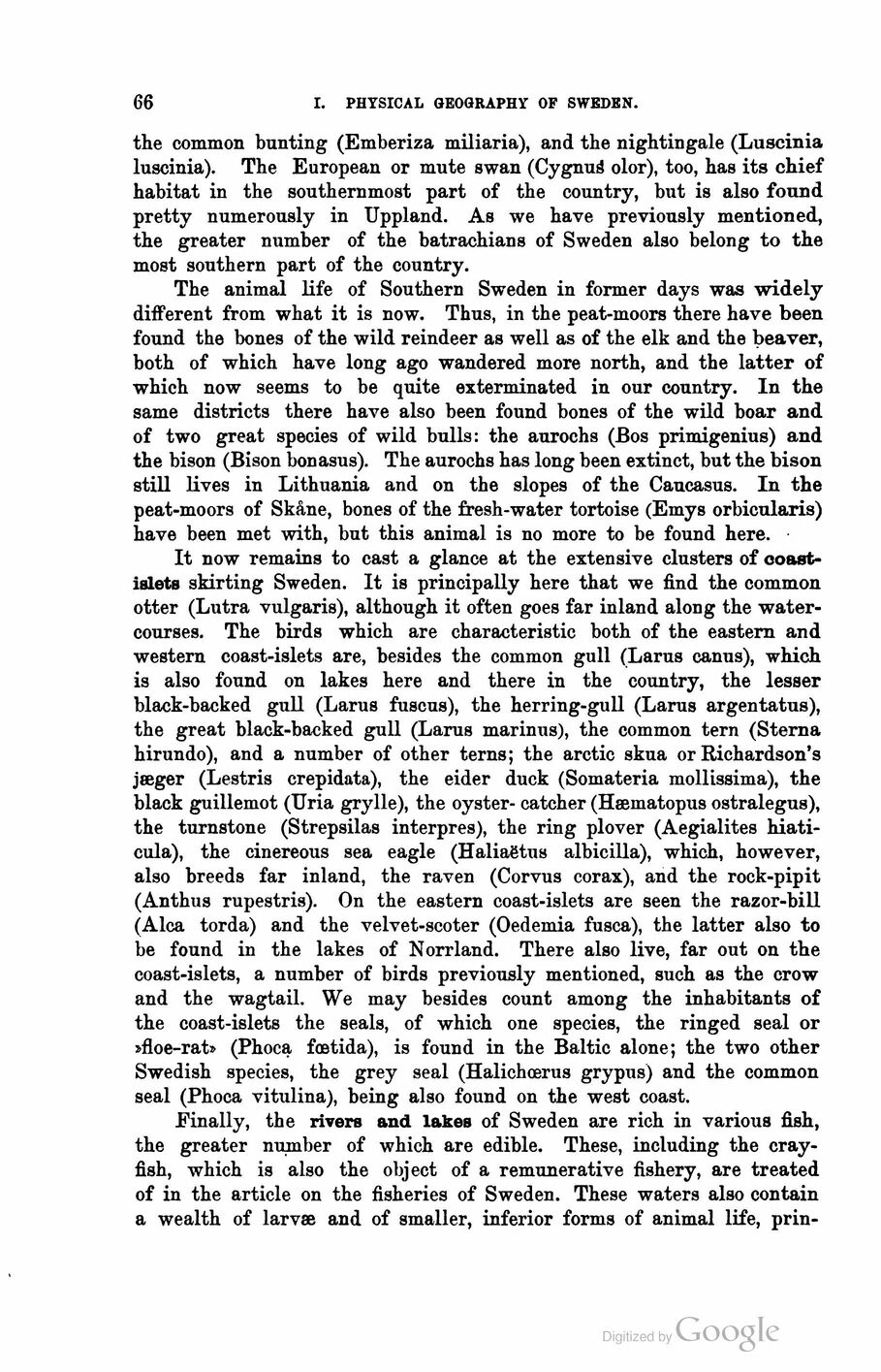
Full resolution (JPEG) - On this page / på denna sida - First part - I. Physical Geography - 5. Fauna. By Prof. T. Tullberg, Ph. D., Uppsala

<< prev. page << föreg. sida << >> nästa sida >> next page >>
Below is the raw OCR text
from the above scanned image.
Do you see an error? Proofread the page now!
Här nedan syns maskintolkade texten från faksimilbilden ovan.
Ser du något fel? Korrekturläs sidan nu!
This page has never been proofread. / Denna sida har aldrig korrekturlästs.
66
I. PHYSICAL GEOGRAPHY OF SWEDEN.
the common bunting (Emberiza miliaria), and the nightingale (Luscinia
luscinia). The European or mute swan (Cygnuë olor), too, has its chief
habitat in the southernmost part of the country, but is also found
pretty numerously in Uppland. As we have previously mentioned,
the greater number of the batrachians of Sweden also belong to the
most southern part of the country.
The animal life of Southern Sweden in former days was widely
different from what it is now. Thus, in the peat-moors there have been
found the bones of the wild reindeer as well as of the elk and the beaver,
both of which have long ago wandered more north, and the latter of
which now seems to be quite exterminated in our country. In the
same districts there have also been found bones of the wild boar and
of two great species of wild bulls: the aurochs (Bos primigenius) and
the bison (Bison bonasus). The aurochs has long been extinct, but the bison
still lives in Lithuania and on the slopes of the Caucasus. In the
peat-moors of Skåne, bones of the fresh-water tortoise (Emys orbicularis)
have been met with, but this animal is no more to be found here.
It now remains to cast a glance at the extensive clusters of
ooast-islets skirting Sweden. It is principally here that we find the common
otter (Lutra vulgaris), although it often goes far inland along the
watercourses. The birds which are characteristic both of the eastern and
western coast-islets are, besides the common gull (Larus canus), which
is also found on lakes here and there in the country, the lesser
black-backed gull (Larus fuscus), the herring-gull (Larus argentatus),
the great black-backed gull (Larus marinus), the common tern (Sterna
hirundo), and a number of other terns; the arctic skua or Richardson’s
jæger (Lestris crepidata), the eider duck (Somateria mollissima), the
black guillemot (Uria grylle), the oyster- catcher (Hæmatopus ostralegus),
the turnstone (Strepsilas interpres), the ring plover (Aegialites
hiati-cula), the cinereous sea eagle (Haliaëtus albicilla), which, however,
also breeds far inland, the raven (Corvus corax), and the rock-pipit
(Anthus rupestris). On the eastern coast-islets are seen the razor-bill
(Alca torda) and the velvet-scoter (Oedemia fusca), the latter also to
be found in the lakes of Norrland. There also live, far out on the
coast-islets, a number of birds previously mentioned, such as the crow
and the wagtail. We may besides count among the inhabitants of
the coast-islets the seals, of which one species, the ringed seal or
»floe-rat» (Phoca fcetida), is found in the Baltic alone; the two other
Swedish species, the grey seal (Halichcerus grypus) and the common
seal (Phoca vitulina), being also found on the west coast.
Finally, the rivers and lakes of Sweden are rich in various fish,
the greater number of which are edible. These, including the
crayfish, which is also the object of a remunerative fishery, are treated
of in the article on the fisheries of Sweden. These waters also contain
a wealth of larvæ and of smaller, inferior forms of animal life, prin-
<< prev. page << föreg. sida << >> nästa sida >> next page >>